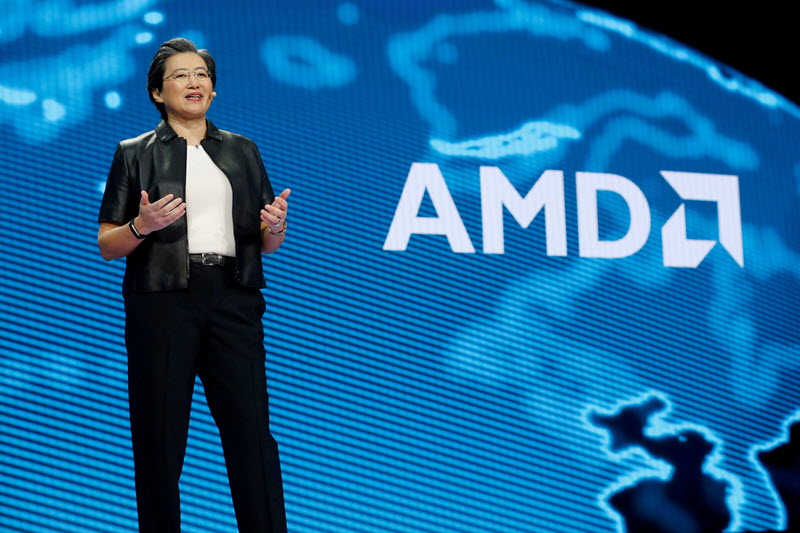Bank of America just raised its EUR/USD forecast
SANTA CLARA, Calif. - Advanced Micro Devices, Inc. (NASDAQ: AMD), a prominent player in the semiconductor industry with a market capitalization of $153 billion, today announced that its next-generation EPYC processor, codenamed "Venice," has become the first high-performance computing (HPC) product to be taped out using Taiwan Semiconductor Manufacturing Company’s (TSMC) advanced 2nm process technology. According to InvestingPro data, AMD has demonstrated robust revenue growth of ~14% over the last twelve months. This development marks a significant milestone in the semiconductor industry, showcasing the collaboration between AMD and TSMC in pushing the boundaries of chip performance and energy efficiency. With a strong financial health score rated as "GOOD" by InvestingPro, AMD continues to maintain a solid foundation for innovation and growth.
The Venice processor is scheduled to launch next year, aligning with AMD’s data center CPU roadmap. In addition to this, AMD has confirmed the successful bring-up and validation of its 5th Generation AMD EPYC CPU products at TSMC’s new Arizona fabrication facility, reaffirming its commitment to U.S. manufacturing.
Dr. Lisa Su, chair and CEO of AMD, emphasized the importance of the partnership with TSMC, stating that the co-optimization of design architectures with leading-edge process technology has been instrumental in maintaining AMD’s competitive edge in delivering high-performance computing solutions.
TSMC Chairman and CEO Dr. C.C. Wei expressed pride in having AMD as a lead HPC customer for both the N2 process and the Arizona facility. He highlighted the collaboration as a driving force behind significant technology scaling that benefits performance, power efficiency, and silicon yields.
This announcement is based on a press release statement and provides a glimpse into the ongoing advancements in the semiconductor industry, where AMD continues to play a pivotal role. The company’s efforts to consistently innovate and deliver leadership products are expected to contribute to the future of computing.
Investors and industry watchers will likely monitor the progress of AMD’s Venice processor and the company’s broader initiatives, including its sustained partnership with TSMC, as they may influence market dynamics and the competitive landscape within the semiconductor sector. With analysts maintaining a bullish outlook and projecting significant profit growth, AMD’s current trading price of $94.50 suggests potential upside according to InvestingPro’s Fair Value analysis. Subscribers can access 13 additional ProTips and a comprehensive Pro Research Report covering AMD’s detailed financial analysis and growth prospects.
In other recent news, Advanced Micro Devices, Inc. (AMD) has been in the spotlight due to several key developments. The company announced that Google Cloud’s new virtual machines, the C4D and H4D, are powered by AMD’s 5th Gen EPYC processors, promising enhanced performance for cloud computing tasks. This move highlights AMD’s commitment to innovation in high-performance computing. Meanwhile, TD Cowen maintained its Buy rating on AMD but reduced the price target from $135.00 to $110.00, citing company-specific challenges and broader market sentiment.
Additionally, KeyBanc Capital Markets downgraded AMD’s stock from Overweight to Sector Weight, expressing concerns over the long-term viability of its AI business in China and increased competition from Intel. Despite the downgrade, KeyBanc raised its revenue and EPS projections for AMD due to strong demand for the MI308 and personal computers. On another front, AMD announced an upcoming event, "Advancing AI 2025," set for June 12, 2025, which will focus on its AI initiatives and new GPU offerings.
The semiconductor industry is also facing challenges from China’s recent tariff decisions. AMD benefits from an exemption due to its outsourcing to Taiwan Semiconductor Manufacturing Company, unlike some U.S.-based manufacturers. Investors are keeping a close watch on these developments as they navigate the complex landscape of trade tensions and competitive dynamics.
This article was generated with the support of AI and reviewed by an editor. For more information see our T&C.
